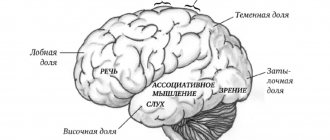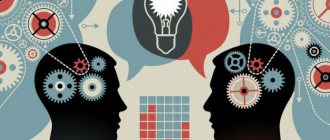January 19, 2021
Hello, dear readers of the KtoNaNovenkogo.ru blog. Today I want to talk about a very interesting thing - a person’s perception of the world around him and other people.
Let's take a look at this process from a psychological point of view to understand its essence. We will find out what properties it has, what types it is divided into, what errors sometimes arise and how a person perceives another person. I hope it will be interesting.
What is perception
Within different sciences, the formulation of this term differs. So, for example, in philosophy, perception is understood as a mental action, as a result of which clear images of objects in the surrounding world are formed in the human mind. At the same time, perception, by definition, is the result of a person receiving information about the surrounding reality, that is, it is a complete image of an object or phenomenon.
Important! Synonyms for perception are concepts such as “sensory cognition” and “perception”.
Reasons for violations
Under certain circumstances, various disturbances in the mechanisms of perception may occur. These may be mental stress, exposure to chemicals, illness or loss of strength. The most famous include hallucinations - images without the real presence of an object.
Hallucinogenic phenomena occur in any modality:
- visual (through images, various events);
- auditory (sounds, clicks, etc.);
- tactile (skin reactions in the form of sensations of cold, burns, crawling insects).
The area of perception is vast, people see the world in different variations, despite the fact that in theory it is the same for everyone.
Signs of perception
Perception is a cognitive process in psychology, the result of which is the formation of a subjective picture of the world through the direct impact of an object or phenomenon on the human senses.
Personality orientation - what is it in psychology, its types
The completed image of an object in the human mind is formed as a result of the combined work of various analyzers. Thus, through vision one can draw a conclusion about the color of an object, and through tactile palpation one can obtain information about its texture. If you take an object in your hands, you can feel its weight, with the help of smell you can feel its smell, and through the receptors on the tongue you can determine the taste. It turns out that in the process of getting to know a subject, cognition and perception merge together.
Important! Perception is always subjective. Individual characteristics of the work of analyzers and a person’s life experience explain the fact that the finished image of an object perceived by different people may differ. The process of perception is inextricably linked with thinking, attention, memory, speech, and the emotional-volitional sphere.
Physiological basis
What is the psychophysiology of perception? The processes that occur during a person’s cognition of the surrounding world (this is an almost continuous process) can be recorded at the level of sensory organs , nerve fibers and the central nervous system; they are called the physiological basis of perception.
The mechanism of their action can be clearly explained as follows:
- stimuli at the nerve endings of the sense organs transmit the received information to the cerebral cortex;
- then it enters the projection zones of the brain, which are called sensory;
- a feeling of the information received and its comprehension is created.
Any “malfunction” of this chain can disrupt the integrity of perception.
For example, loss of vision , as a property of a sensory organ, limits the resulting image in terms of its color, volume, shape, etc., and a failure at the sensory level will lead to the fact that a person will perceive what he sees only as a set of light and color spots.
The nerve connections through which the process of perception works come in 2 directions:
- formed after the influence of one analyzer - for example, the noise of water in a river, which we do not yet see, affects only our hearing aid;
- inter-analyzer - figuratively speaking, they arise when we approach the river, here a whole complex of sensations comes into force, including associative ones.
Levels of perception
Mechanical memory - what is it in psychology and how is it characterized?
The process of forming a holistic image of an object goes through 4 levels:
- One of the analyzers notices the object. A person can see it, smell it or hear some characteristic sound.
- Correlating the signal from the analyzer with a particular object. This process occurs with reference to the existing in memory ideas about the objects of the surrounding reality and the correlation of the detected feature of the object with one or another standard.
- Identification and identification. As a result of mental activity, a person comes to the conclusion about what kind of object it is, what it is called, and what it is needed for. The result of the process is the formation of a complete image of the object.
Forming an image of an object
Modality
There are 4 sensory information perception systems (models - hence the name) that people use:
- the visual system involves the perception of color and shape, that is, what we see;
- the auditory system uses sounds, their volume, timbre, rhythm, frequency;
- the kinesthetic system perceives taste, smell, temperature;
- digital uses logical constructions.
Types of perception in people
All analyzers always participate in the process of accepting the surrounding reality, but only 1 of them is the leading channel for obtaining information. So, when reading, the leading channel is vision, when listening to music – hearing, etc. Perception is usually classified on various grounds.
By modality
Adolescence crisis in psychology - what is it, reasons
According to modality, the following types of perception are distinguished:
- Visual – the formation of a complete image of an object in the mind;
- Auditory – the ability to perceive sounds;
- Tactile - obtaining information about a particular thing through touching it;
- Olfactory – the ability to distinguish odors;
- Gustatory – expresses the formation of ideas about food based on the work of taste buds.
Depending on the host analyzer
Depending on which analyzer is the leading one, perception is divided into simple and complex. Simple types include kinetic (based on sensations and movement), auditory (based on hearing) and visual (based on vision).
The main complex types and properties of perception are based on a combination of signals from different senses. If a person equally often relies on 2 or more analytical systems, this leads to the development of motor-visual-auditory or motor-visual perception.
Additional Information. In addition, there are special types of perception that appear in a specific situation during certain human actions. For example, when a person determines the distance to a destination, one type of perception is at work. When a man thinks about how a girl treats him, analyzing her behavioral reactions, another type of this mental process is activated.
How does she feel about me?
By update method
In psychology, such types of perception are distinguished as voluntary and involuntary. If this process is voluntary, then it has a specific goal, and the person takes specific actions to achieve it. Voluntary perception occurs when a person reads a scientific text with the desire to learn something new.
Involuntary perception is due to the bright characteristics of the object. It manifests itself, for example, when a late student enters the classroom - everyone present turns their heads at the sound of the door opening.
Space, time and motion
The interaction and combination of different sensations gives the ability to perceive certain forms of existing matter of time, space and movement. Space is almost always perceived by humans. This includes assessing the presence and position of one's own body. As well as visual reading - direction, distance, shape, depth and volume.
The distance of objects and the location of light and shade are of great importance. The olfactory, auditory, vestibular and other sensory systems are involved in the perception of space.
The perception of time is a very subjective concept, but some patterns are noted. All phenomena in life occur in time. The law of present and past tense is that the more the present is filled with events, the shorter it seems. The waiting periods feel very long.
In memories, the opposite picture is present - an eventful period of time is perceived as longer. Estimation of time is very individual. The assessment is influenced by the nature of the activity, structure and motivation. High interest speeds up the time interval, while low interest slows it down. The personality structure, motives, emotions and age of a person also influence here.
Movement is a reflection of the variability of the location of an object in space; the direction and speed of movement are also taken into account.
There are perceptions:
- according to the form of movement - circular, arc-shaped, straight, etc.;
- vibration amplitude - small, medium and large;
- direction - right, left, up, down;
- by duration - short, long;
- by acceleration and speed - fast, slow, smooth or intermittent;
- by the nature of the movement - flexion, rotation, extension.
Basic properties of perception with examples
The mental process under consideration has the following properties:
- Integrity is a characteristic of the final image that arises as a result of a combination of sensations. The final image is always complete. For example, a fly is perceived by a frog as an object of hunting only when the fly moves. If the fly is motionless, the frog does not try to catch it, since it does not perceive it as an insect.
- Constancy - once acquired characteristics of a particular object, a person tends to correlate it with this particular object for a long time, accurately forming the final image. Minor changes in the characteristics of an item do not lead to difficulties with its classification. So, for example, a young man dates a tall girl who has blue eyes and blond hair. One day his girlfriend dyed her hair brunette. But he still perceives her as his partner; she has not become a stranger to him.
- Subjectness - the ability to combine an object with a generic group according to key characteristics. For example, green, round, sweet - this is an apple. Green, long, with paws and a tail - this is a crocodile. The process of classifying items into generic groups may take some time. Sometimes, for a correct correlation, a person needs to come up and take a closer look at the object or pick it up.
Objectivity of perception
- Structurality is reflected in the complexity of the perception process, which cannot be reduced simply to the sum of sensations from different senses. Replacing one of the key characteristics leads to the formation of a completely new image. So, for example, something large, iron and capable of floating is a ship. However, a large, iron one, capable of moving along railroad tracks is a train, not a ship.
- Selectivity – selection of 1 object from the background. The scope of perception is limited. A child cannot play with many toys at the same time. First of all, he will take the brightest or largest toy. This turns on selectivity: the baby chooses the most eye-catching object by color or size. Having chosen his favorite toy from a variety, the child loses interest in the others for a while; only the best one is in his field of perception.
- Apperception is the dependence of image formation on the individual characteristics of a person’s analytical systems and his life experience. The same object can be perceived differently by different people. So, for example, the Bible for believers is one of the main books of life, which sets out the rules of life and the foundations of society, but for an atheist it seems to be just a book that is no different from any other work of art.
- Perception activity is a person’s ability to be aware of the surrounding reality and accumulate experience in using objects. For example, initially the baby does not know what function the spoon performs. He can knock on the wall with it, look at it like in a mirror, dig sand with it. One day his mother shows him that he can eat with a spoon. Having learned this, the baby understands that a spoon is a cutlery, and not a hammer, a mirror or a spatula.
Classification of properties
Perception is the knowledge of a complex image of an object. A person forms his own model of the objective external world. At the first contact with an object, the human brain receives knowledge about it and forms an image of sensation, then on this basis an image of perception is created.
The leading properties of perception (perception) include:
- Integrity.
- Meaningfulness.
- Generality.
- Constancy.
- Objectivity.
- Selectivity.
Integrity refers to the knowledge of information or an object as a whole, despite the absence of essential details. An object is reflected in the totality of all its properties. Let's say a house without a roof, windows, pipes will still be recognized as a house, only unfinished or destroyed.
Meaningfulness is an understanding of what exactly is perceived and its relationship with knowledge and past experience. Even in unfamiliar objects, similarities with familiar objects are detected. A person who is far from technology will create a connection between the structure he sees with light bulbs and wires, assuming that it is a scientific device.
Generalization is a concept when individual objects are classified as homogeneous according to certain characteristics.
Constancy of perception is the constancy of the perceived shape, size and color of an object, regardless of significant changes in conditions. For example, a bird in flight, in a cage, or in a tree is perceived the same way - as a bird. The same applies to color perception. Red will always remain so in any light. Thanks to constancy, a person recognizes objects under any conditions.
Objectivity is a meaningful, integral image when not only the color, shape or size is perceived, but the functions, properties, and purpose of the object. For example, a spoon has not only color and shape, but also a purpose - a cutlery. The meaning put into the image is important.
Selectivity - an object is distinguished from others based on personal experience. Based on the described characteristics, perception has properties that determine its productivity:
- Volume is the number of objects perceived simultaneously.
- Speed is the time spent on perceptual actions (detection, recognition, discrimination).
- Accuracy is the correspondence of the image to the characteristics and task assigned to the person.
- Completeness—level of compliance.
- Reliability is the duration of perception with the required accuracy, adequate acceptance of an object at a given time and condition.
By analyzing the indicators, one can judge a person’s perceptual abilities.
Errors in Perception
As in any other mental process, errors occur in perception, as a result of which a person forms erroneous ideas about objects and phenomena. Typical perceptual errors include illusions and hallucinations.
Illusion
Illusion is a distorted perception of objects or phenomena. There are 2 types of illusions:
- Affectogenic illusions caused by emotions and feelings. For example, a timid person can clearly see a monster in the shadow of a bush, while a person with low self-esteem seems to be disliked by his superiors and is constantly being picked on.
- Pareidolic illusions, which are characterized by the appearance of fantastic images when interacting with reality. For example, black spots on a white sheet can be mistaken by a person for insects.
Hallucinations are a type of image that does not actually exist. Hallucinations are one of the symptoms of a mental disorder. So, a person can hear voices, he can imagine the presence of someone in the room, although at that moment in time there is no one next to him, and he is in silence.
Additional Information. A healthy person may experience hallucinations as a result of using psychotropic substances. Hallucinations can also be induced through hypnosis.
The illusion of reality
The illusion of perception occurs when reality is reflected distortedly, while the effect is sustainable. Illusions can occur in many people under the influence of physical, physiological and psychological reasons.
The breaking of a spoon in a glass of tea is classified as a physical illusion, and the splitting of the image when pressing sideways on the eyeball is considered a physiological illusion. A psychological illusion occurs when identical lines are overestimated up or down when their lengths are objectively equal.
Another example considers overvaluing the top parts of the figure. When dividing a vertical line in half, a person often makes the mistake of setting the middle much higher than the real one.
Person's perception by person
In social science, a peculiarity of people's perception of each other has been identified. When meeting someone, it is not possible to obtain enough information to form a complete, complete image. Only in the process of long-term communication do people get to know each other so much that a psychological portrait of a friend is formed in their minds.
At the time of the first meeting, people try to make a good impression if they are interested in a communication partner. They seem to stand on their tiptoes, wanting to become morally superior. At the very beginning of a relationship, people diligently disguise their shortcomings and weaknesses. A person’s primary image of an interlocutor is formed based on an analysis of his posture, posture, gestures, and communication style.
People's perceptions of each other
In addition, if the interlocutor reveals his profession, the person mentally attributes to him the stereotypical qualities of a typical representative of a particular field of professional activity. Thus, people tend to believe that teachers lead a correct lifestyle, and musicians are vulnerable, impressionable, and romantic.
A person’s social status also has a significant impact on the opinion others have about him.
Interesting fact. If a person has a beautiful appearance, then communication partners tend to endow him with positive personal qualities that he actually does not possess. If outwardly the interlocutor reminds a person of one of his relatives, sympathy for him arises from the first minutes of communication.
Development of perception in children
The foundations of perception as a mental process are laid in infancy. However, at an early age, the baby’s perception is still very imperfect. In the first years of life, a child develops visual-tactile and visual-motor connections that arise in the process of manipulative activities with objects. Later, the manipulation turns to “feeling” a new object with the gaze - this indicates a new stage in the development of perception.
In preschool and primary school age, perception is determined by the impressionability and emotionality of children: involuntary perception prevails over voluntary perception.
The most difficult for children to master are the spatial properties of objects that are associated with visual, kinesthetic and tactile sensations. During preschool childhood, children successfully master concepts such as shape, size and size of objects, learn to determine the distance and spatial arrangement of objects relative to each other.
The perception of time poses serious difficulties for children of primary preschool age. They do not always correctly use the words “tomorrow”, “yesterday”, “later”, “earlier”.
Children's perception of time
As the child masters the surrounding world, as well as systematic schooling, the child’s conditioned reflex connections improve, which is an impetus for the development of perception.
The key role in the development of children's perception belongs to adults. Thus, parents and teachers teach children how to operate with objects, guide the child’s development process, and draw his attention to the essential characteristics of objects and phenomena of reality. An adult’s detailed and complete answers to a child’s questions about certain objects and phenomena will mean a lot.
Attention! To develop a child’s perception, it is necessary to organize his play and practical activities with objects. During the game, children learn to distinguish the basic properties of objects: color, weight, shape, size. In order for a child to study an object and understand its purpose, he needs to touch it and try to perform various actions with it. During the game and practical activities, optimal conditions are created for the interaction of analyzers, which leads to the formation of a holistic view of the world.
Children's artistic activities have enormous potential for the development of perceptual skills. In drawing from a model and in the process of sculpting, children learn to feel proportions, convey the shape and size of an object, and distinguish between shades of a palette. Thus, by older preschool age, the child’s perception becomes controlled and arbitrary.
During the period of schooling, perception is improved due to the variety of academic disciplines and various types of activities of children under the guidance of a teacher. To develop perceptual skills, the teacher must use visual aids: firstly, this stimulates the work of several analyzers at once, and secondly, it contributes to better memorization of information. Independent search work of students is of great importance.
Thus, perception plays an important role in human life. Perceptual skills formed at a high level ensure successful learning, harmonious personal development, and the ability for scientific creativity. It is important for adults to remember that this ability will not be formed by itself; it is necessary to create conditions for the child to play with different objects from an early age. It is important in early childhood to give the opportunity to develop sensory standards and cognitive interest. If these conditions are met, during school the child will be active and independent in learning about the world around him.
Brief perception of reality
LiveInternetLiveInternet
Saturday, July 13, 2013 01:08 + in the quotation book
Topic 4-5. Sensation and perception There is nothing in consciousness that was not previously in sensation.
Ernst Heine Has it ever occurred to you to count the entire stock of knowledge about objects, phenomena, i.e.
about everything that surrounds you? Even if someone willing to do so was found and did the calculations, he would be surprised that the stock of knowledge is so huge. How do we gain knowledge about the world around us?
A person receives the very first knowledge about the world around us with the help of special mental processes - sensations and perceptions.
Sensations and perceptions are the main provider of knowledge. Thanks to them, a person distinguishes objects and phenomena by color, smell, taste, temperature, smoothness, size, volume and other characteristics. Sensations and perceptions underlie more complex mental processes - thinking, memory, imagination. Thanks to accumulated ideas obtained through sensations and perceptions, we learn to adapt and navigate the world around us. Let's take one of the simplest examples. If we are lightly dressed and get caught in the rain without an umbrella, we return home in wet clothes, dirty, and cold. The lesson is not in vain - we remember our unpleasant feelings. The next time we are going to leave the house, we listen to the weather forecast and not only take an umbrella, but also put on a raincoat or jacket and appropriate shoes. Sensations and perceptions are similar, but there are significant differences between them. ^What are sensations?
Sensations arise from direct contact with an object.
So, for example, we learn about the taste of an apple that we were treated to when we try it. It looks red and beautiful, but when you bite into it, it may turn out to be sour. How did our favorite variety of apples come about? We tried different varieties, our feelings summed up - this apple is sweet for some, sweet and sour for others, sour for others - I like it. However, there are people who love all apples. ^ Sensation is a mental process that occurs in a person when the sense organs are exposed to objects and phenomena, which consists in reflecting (cognition)
the individual properties of these objects and phenomena. Underline the word “separate”.
All surrounding objects have many properties. Touch the desk. What do you feel? By touching, we gain knowledge not about the entire desk, but only about its individual properties - it is hard, dry, rough. Now look at the desk. What is she like? Through vision we can say that the desk is of a certain color, shape (gray, dirty, written on, rectangular, etc.). Knock on the desk. How do you feel? Through hearing we determine that the desk is wooden and makes a dull sound. All these are examples of individual sensations through which we experience the world around us. Remember: through sensations we receive information not about the entire object, but only about its individual properties. ^ Mechanisms of sensations.
To make it even clearer what sensations are, let’s consider how this process occurs.
Have you heard of the concept “ analyzers
”?
This is a complex nervous mechanism that produces a subtle analysis of the surrounding world, i.e.
highlights its individual elements and properties. Each analyzer is designed to isolate and analyze certain information.
The most famous analyzers in humans are: visual, auditory, gustatory, olfactory, tactile - according to the five basic senses. Each analyzer has a specific structure: 1) receptors
- sensory organs (eye, ear, tongue, nose, skin, muscles);
2) conductor
- nerve fibers from receptors to the brain;
3) central sections
in the cerebral cortex.
How does the sensation happen? For example, we touched the desk. The receptors on the skin of the fingers received a signal, they transmit it through conductors to the cerebral cortex, where complex processing of the received information takes place (the sensation actually occurs) and the person receives the knowledge that the table is cold, rough, etc. Or a hot iron... In the cerebral cortex, information is processed and an instant conclusion is made: it’s hot and painful. Immediately there is a reverse signal: withdraw your hand. All analyzer departments work as a single unit. If one department is damaged, there is no sensation. For example, people born blind will never know the sensation of color. We experience the world around us and communicate with each other using our senses: eyes, ears, nose, skin, tongue. Through these organs, information enters the brain, and we know where we are, what is happening around us, etc. Think about how a person hears sounds? “I hear with my ears!” - you say, but this is an incomplete answer. A person hears with the help of the hearing organ, which is complex. The ear is only part of it. The auricle, or outer ear, is a funnel through which a person catches air vibrations. After passing through the auditory canal, they affect the eardrum. The vibrations of the membrane are transmitted to the auditory ossicles and reach the inner ear. Further along the nerves, the impulses reach the auditory center located in the cerebral cortex. Only with its help can we recognize sound signals. This is how sensations arise. It is not without reason that the definition notes that sensations arise when surrounding objects and phenomena influence the analyzers (sense organs). ^ Types of sensations.
The sensations, as you already understand, are different.
The main sensations associated with the five human senses are identified. 1. Visual sensations
.
Through them, a healthy person receives about 80% of information about the world around him - sensations of color and light
.
What, thanks to visual sensations, can we say about the world around us?
Visual sensations help to navigate in space.
Colors affect people differently. ^ Red
– excites, activates;
Orange
– cheerful and cheerful, sociable;
Yellow
– warm, invigorating, flirtatious, crafty;
^ Green
– calm, cozy mood;
Blue
- calm, serious, sad, invigorates mental work; if there is a lot of it, it causes coldness;
Purple
is mysterious, a combination of red and blue: attracts and repels, excites and sad.
2. Auditory sensations.
They occupy the second place in importance in a healthy person.
The main purpose for humans is speech recognition and other sound signals
.
Speech, music and noise sensations are distinguished. Loud noise has a negative impact on a person (on mental activity and the cardiovascular system). Why do we need two ears? Maybe one would be enough? Two ears allow you to determine the direction of the sound source. If you close one ear, you will have to turn your head in all directions to determine where the sound is coming from. The importance of hearing in a person’s life is very great. With the help of hearing, people receive information and communicate with each other. The child hears the speech of adults, and at first simply recognizes the sounds, and then begins to imitate them. Little by little he learns to pronounce individual sounds and words, and then masters speech. Rear 1.
Using a simple experiment, check who has better hearing.
To do this, you need to sit sideways to each other at a distance of about one and a half meters and close your eyes. The presenter brings his watch closer to you and away from you in turn. When you hear ticking, you say, “I hear it.” Having stopped hearing, “I don’t hear.” 3. Taste sensations.
The human tongue has taste buds that are responsible for
four taste sensations
.
The tip of the tongue recognizes sweet sensations, the back surface of the tongue recognizes bitter sensations, and the sides of the tongue recognize salty and sour sensations. As a person becomes full, the role of taste sensations increases, but a hungry person will eat less tasty food. Food consists of different components and evokes complex taste sensations. When we eat, we feel heat, cold, and sometimes headaches due to changes in atmospheric pressure, all of which affect the taste of food. In addition, taste sensations are not perceived in their pure form; they are associated with olfactory sensations. Often what we think of as “taste” is actually smell. For example, coffee, tea, tobacco, lemons stimulate the organ of smell more than the organ of taste. 4. Olfactory sensations.
Responsible for
recognizing odors.
In modern man, they play a minor role in understanding the world, but they influence the emotional background and well-being of a person.
When vision and hearing are affected, the olfactory sensations become important. Many animals, such as dogs, live solely by smell. In our nose, the membrane of sensory cells responsible for the sense of smell occupies an area about the size of a fingernail on both sides. In a dog, if you straighten it, it will cover more than half of its body. A person’s weak sense of smell is compensated by the higher development of other senses. By the way, when we simply breathe, the stream of air passes the membrane, and therefore we have to sniff - pass air over the membrane in order to smell it. There are five main types of smell that we can detect: 1. floral; 2. spicy (lemon, apple), 3. putrid (rotten eggs, cheese), 4. burnt (coffee, cocoa), 5. ethereal (alcohol, camphor). Why does a person need taste and smell sensations? 5. Tactile sensations - a combination of skin and motor sensations when feeling objects.
With their help, a small child learns about the world.
For people without vision, this is one of the important means of orientation and cognition. For example, when reading, Braille is used. Deaf people, in order to understand what the interlocutor is saying to them, can recognize speech by the movement of the vocal cords (by placing the back of the hand on the speaker's neck). Deaf-blind Elena Keller was able to fully exist in society through the tactile-motor learning system. She received an education, graduated from college, defended her dissertation, and held a government position in the employment of people with disabilities. The sense of touch is associated with sensations of temperature, pain, pressure, humidity, etc. These are the main types of sensations. ^ Others are also highlighted. 6. Organic – sensations of hunger, thirst, satiety, suffocation, abdominal pain, etc.
Receptors for these sensations are located in the corresponding walls of the internal organs: esophagus, stomach, intestines.
Everyone knows the feeling of hunger. But how do we know when we feel hungry? Hunger has nothing to do with an empty stomach, as many people think. After all, patients often, despite the lack of food in the stomach, do not want to eat. Hunger occurs when there is a lack of certain nutrients in the blood. Then a signal is sent to the “hunger center” located in the brain - the work of the stomach and intestines is activated. This is why a hungry person often hears his stomach growling. How long can you go without food? It depends on the individual. A very calm person may not eat for longer, since protein reserves in his body are consumed more slowly than those of an easily excitable person. The world record for the duration of fasting was claimed by a woman in South Africa, who, according to her, lived only on water for 102 days! ^ 7. Kinesthetic (motor) sensations - sensations of movement and position of body parts
.
Do a little experiment. Close your eyes and stand in some position: follow the command “at attention”, and then take the same position again. Think about which of the five senses helped you repeat the movement? It was a motor sensation caused
by irritation of receptors located in muscles, ligaments, and joints.
When walking, dancing, cycling, we feel a change in the speed or direction of our movement thanks to the vestibular apparatus of the inner ear. 8 ^.
Vibration sensations - occur when the surface of the body is exposed to air vibrations produced by moving or oscillating bodies. They play an important role in the deaf and blind.
With the help of these sensations, deaf-blind people learn about the approach of a vehicle or a person, touching the lips of a speaking person and feeling their vibration, they can learn the alphabet and then speak. are distinguished separately .
There is evidence that a person, using ordinary senses, can perceive stimuli that are beyond the lower threshold of his sensitivity, i.e.
a person reacts not only to those signals that he is aware of, but also to those that he is not aware of. Premonition and foresight are built on this. ^ Examples from life: 1. Pshonik conducted an experiment with his daughter in 1952. In the kitchen during breakfast, the daughter kept her finger on the button to which the current was connected. When the light came on, the current flowed, you had to have time to take your finger off the button. Over time, the girl, without the light bulb, withdrew her finger, reacting to subthreshold sensations. Together with the light bulb, Pshonik turned on a generator of high-frequency sounds that were not audible to the ear, the girl reacted to these sounds. 2. “25th frame.” The human eye consciously perceives 24 frames per second, and the video is based on this. An experiment was conducted: while watching a film in a cinema, the 25th frame with an advertisement was turned on: “Buy suspenders.” The human eye cannot consciously read this inscription, but the picture of the frame leaves an image on the retina. None of the viewers will say that they saw this inscription, but 15-20% of the viewers went to buy suspenders. This technique is prohibited. ^ The importance of developing sensations.
What happens if a person is deprived of many sensations from birth?
This person will develop more slowly and worse.
It is not for nothing that blind children begin to walk and talk later. Sensations are formed and developed as a result of practical actions and exercises. Therefore , it is necessary that the child receives the maximum number of different sensations
(through games, toys, communication).
Mowgli children are examples of the importance of early child development. So, in 1825, a young man of about twenty-two years old was found in a German city. He avoided people, bumped into objects, and did not respond to speech. Gradually he learned to speak and said that he lived in a cellar and remembered hands that sometimes appeared and gave bread and water. Once a week I woke up feeling washed and wearing new underwear. Then they took him to the outskirts and left him. There are people who see only two colors or see 40 colors. Why does this difference depend? From human experience. For example, 5 thousand years ago The Egyptians saw only 6 colors. This was explained by the peculiarity of the colors of the landscape where they lived. ^ The sensations depend on the exercises.
Every person has an innate ability to sense. Over the course of life, sensations transform and become more diverse. But for this they need to be developed. To make sensations more perfect, it is necessary to specifically exercise the senses. Many professions require subtle sensations and, in turn, contribute to their development. For example, artists, musicians, dancers, foreign language teachers, and musical instrument tuners have significantly higher sensations than other people. The blind have excellent hearing, the deaf have excellent vision. The Germans often blinded their hunting dogs in one eye and one ear, which increased their sense of smell and vision. This means that sensations can and should be improved.
Task 2.
We can check your tactile threshold for differences in sensations, i.e.
the minimal difference between two stimuli that produces a noticeable difference in sensation. Work is carried out in pairs. Take a paperclip and straighten it. One of you closes your eyes and extends your hand, the other places the two sharp legs of a paper clip on the back of your hand. At first, the distance between the legs is about 6 cm, gradually reduce this distance until the participant has the sensation of one touch (although the two ends of the paper clip are still touching). Measure the distance between the ends of the paperclip. This is your tactile sensitivity threshold. The lower this indicator, the higher the tactile sensitivity. ^What is perception?
The second mental process, which is responsible for our primary knowledge of the world around us and is closely related to sensation, is perception.
^ Perception is a mental process that occurs in a person when the sense organs are exposed to objects and phenomena, which consists in a
holistic reflection (cognition) of these objects and phenomena. Underline the word “whole”.
As you already understand, sensations allow you to reflect and perceive only individual properties of objects: colors, shape, size, smoothness, sounds, temperature, etc. But we will not receive objects through sensations of a complete image. So, if you describe a lemon through sensations, it will be something yellow, sour, oblong, rough and nothing more. Perception allows us to “see” the holistic image of an object. During perception, the individual properties of objects are combined into a single image. We see objects not only with our eyes, but also with our minds. Information about the world around us gradually accumulates in the brain - we have experience that is involved in the process of perception. ^ Perception is based on a person’s sensations and past experiences.
Look at the notebook and describe it.
How will you create her image? From sensations of color, shape, volume, roughness. Why are you sure that this is a notebook and not a ball or a shirt? Only thanks to past experience. When perceiving familiar objects, recognition occurs immediately; a person only needs to combine 2-3 signs. For example, you have geranium at home, you know what it looks like. When you come to visit someone and see the same geranium, you will recognize it instantly. And you see the plant standing next to it for the first time and wonder what it’s called. ^ Types of perceptions.
According to the action of the predominant analyzer, there are visual, auditory, olfactory, gustatory, and tactile perceptions.
There are also more complex types of perception that arise as a result of the work of several analyzers. 1. Perception of objects.
All types of sensations operate in the perception of objects.
When we see an orange, we combine visual, gustatory, olfactory and tactile impressions. The perception of individual objects is a very complex process. We identify the main features of an object, discard the unimportant ones, and then recognition of the object occurs. When perceiving familiar objects, recognition occurs quickly. Every time we perceive, we form a visual image of an object. We call this object a word. Therefore, perception is closely related to speech. When we perceive an unfamiliar object, we try to establish its similarity to a familiar one. For example, perceiving a watch and mentally calling it with this word, we are distracted from such unimportant features as the material from which the case is made, size, shape and highlight the main feature - the indication of time. Does everything that surrounds a person fall into his field of perception? How does the choice of an object of perception occur? 2. Perception of space,
i.e.
the distance of objects from us and from each other, their shape and size
.
These perceptions are built on the basis of a combination of visual, auditory, skin and motor sensations. Only accumulated experience gives us a correct idea of the size of objects. A person standing in a boat far from the shore appears much smaller than a person standing on the shore. But no one will say that one person is big and the other is small. We say: one person is close and the other is far from us. By the strength of the sound of thunder, we determine the distance separating us from an approaching thunderstorm; using touch with our eyes closed, we can determine the shape of an object. Through the experience of perceptions, we form an idea of perspective. When we look at the rails going into the distance, we see that they converge on the horizon line. Our eyes see this, and our brains, therefore, our experience suggests that they do not converge anywhere. The children have no experience yet, they think that the rails converge, so they ask: what is there? 3. Perception of time.
There is
a reflection of the duration and sequence of events
occurring in the world.
This is a very subjective process. The perception of the duration of time depends on what fills that time. Time periods filled with something pleasant are perceived as shorter. So it feels like a change always flies by instantly, and a boring lesson lasts a very long time. Depends on age: children perceive time as dragging on for a long time, while for adults, days and months fly by very quickly. Why is it that when we feel good, time is perceived as passing quickly, and when we feel bad or bored – as dragging slowly?
There are people who always know what time it is.
Such people have a well-developed sense of time. The sense of time is not innate, it develops as a result of accumulated experience. Task 3
.
Check who has a well-developed sense of time. Periodically, without looking at the clock, say what time it is; the one who guessed correctly more often (or was closer to the correct time) has an excellent sense of time. 4. Perception of movement.
There is
a reflection of changes in the spatial relationships of the environment and the observer himself
.
It involves visual, auditory, muscle and other sensations. If an object moves in space, then we perceive its movement due to the fact that it leaves our field of best vision and forces us to move our eyes or head. If objects move towards us and we try to focus our gaze on them, our eyes converge at one point and the eye muscles tense. Thanks to this tension, we form the idea of distance. By internal sensations we perceive the movements of our own body. Perceiving the world, a person highlights something in it, but does not notice something at all. For example, during a lesson you can enthusiastically watch what is happening outside the window and absolutely not notice what the teacher is saying there. What a person highlights is the object
of perception, and everything else is
the background
.
Sometimes they can change places. Task 4
.
Look at the image of the young woman half turned away. Can you immediately notice an old woman with a big nose and chin hidden in her collar? The individual uniqueness of perception depends on the mental state of a person at the moment. If he is cheerful, cheerful, joyfully excited, then one perception, if he is scared, sad, angry, then a completely different one. Therefore, the perception of the same person, event, phenomenon by different people is so different. Thus, each perception includes not only sensations, but also a person’s past experience, his thoughts, emotions, i.e. Every perception is influenced by a person’s personality. ^ Illusions of perception.
Sometimes our senses and our perceptions let us down, as if deceiving us.
Such “deceptions” of the senses are called illusions.
| ^Which square is larger? |
Vision is more susceptible to illusions than other senses. No wonder they say: “don’t believe your eyes”, “optical illusion”. Light objects against a dark background appear enlarged compared to their actual size. A dark object appears smaller than a light one of the same size. These illusions are explained by the fact that each light outline of an object is surrounded by a light border on the retina. It increases the size of the image. In general, all light objects seem larger to us than dark ones.
People appear thinner in a dark dress than in a light one.
| ^Which of the horizontal segments is longer? |
| ^ Which lines are longer? |
When comparing two figures, one of which is smaller than the other, we mistakenly perceive all parts of the smaller figure as smaller, and all parts of the larger figure as larger. This is clearly visible in the figure: the upper segment in it seems longer than the lower one, although in fact they are equal. Look at the picture, which shows lines - horizontal and vertical. Which ones are longer? You will say that the vertical ones are longer. This is a visual error. Lines of equal length. The horizontal ones are divided in half by the vertical ones and therefore seem to be shorter. Artists, architects, and tailors are well aware of visual illusions. They use them in their work. For example, a tailor sews a dress from striped fabric. If he arranges the fabric so that the stripes are horizontal, then the woman in this dress will appear taller. And if you “lay” the stripes horizontally, the wearer of the dress will appear shorter and thicker. Upside-down is a type of optical illusion when the nature of the perceived object depends on the direction of gaze. One of these illusions is the “duck hare”: the image can be interpreted as both an image of a duck and an image of a hare.
| ^ How many bars? |
| Is it possible to create such a figure? |
Sometimes illusions arise under the influence of strong emotions: For example, in fear a person can mistake one thing for another (a stump in the forest for an animal.)
| ^What do you see in the picture? |
There is an illusion of non-existent objects, most often based on a false perspective, ambiguous connections. There are illusions caused by the relationship between “figure” and “ground”. Looking at the drawing, we see first one figure, then another. These could be stairs going up or down, or two profiles changing to a drawing of a vase, etc. Sometimes other senses deceive us. If you eat a piece of lemon or herring and wash it down with tea with a little sugar, the first sip will seem very sweet. An interesting phenomenon is experienced by astronauts. When weightlessness sets in, they experience the illusion of turning over. That is, they think they are upside down and feet up, although in fact their body is positioned correctly. There are entire illusory works of art. They are a triumph of fine art over reality. Example: drawing “Waterfall” by Maurice Escher. The water circulates here endlessly; after the wheel rotates, it flows further and ends up back to the starting point. If such a structure could be built, then there would be a perpetual motion machine! But upon closer examination of the picture, we see that the artist is deceiving us, and any attempt to build this structure is doomed to failure. Task 5.
All people have illusions of perception. Ask your friends to look at these drawings, and they will create the same illusions as you.
| Which of the central circles is larger? | Which of the vertical segments is longer? |
| ^Are the lines parallel? | How many legs does an elephant have? |
New concepts
:
perception, sensation, kinesthetic, organic, vibration sensations, illusions of perception. Test questions.
- What is sensation and perception?
- What are the similarities and differences between these processes?
- What are the physiological mechanisms of sensations?
- What types of sensations and perceptions do you know? What do they mean?
- What role do sensations and perceptions play in our lives?
- What are perceptual illusions? Give examples of illusions.
- Describe what sensations make up the image of the perception of a pine tree.
- Why do we notice dust on furniture and not feel the specks of dust that land on our face?
- Choose the correct answer.
9.1.
During training, the sensitivity of the senses: a) does not change;
b) improves to a certain limit; c) improves without limit; d) gets worse. 9.2.
The perception of objects depends most of all on: a) the quality of a person’s sensations and experience;
b) on the temperament and character of a person; c) from the movement or rest of these objects; d) all answers are correct; d) all answers are incorrect. Follow the link and complete the test tasks. Test tasks. Literature
1. Rogov E.I.
Psychology of cognition. – M.: Vlados, 2001. 2. Dubrovina I.V. and others. Psychology. – M.: Academy, 1999. 3. Yanovskaya L.V. Basics of psychology. – M.: World of Books, 2007. 4. Proshchitskaya E.N. Workshop on choosing a profession. – M.: Enlightenment, 1995. 5. https://ru.wikipedia.org/wiki/Sensation 6. https://www.effecton.ru/185.html 7. https://www.e-psy. ru/html/publish/st6.html 8. https://works.tarefer.ru/70/100071/index.html 9. https://www.diclib.com/cgi-bin/d1.cgi?l= ru&base=colier&page=showid&id=8872 10. https://psi.webzone.ru/tema/tema8.htm 11. https://ru.wikipedia.org/wiki/Perception 12. https://net22.ru/category /vospriyatie/ 13. https://azps.ru/articles/proc/indexvo.html Illusions of perception
1. https://www.psy.msu.ru/illusion/ 2. https://vadim-andreev.narod. ru/ufo/iluzia.htm 3. https://ru.wikipedia.org/wiki/Optical_illusions 4. https://ru.wikipedia.org/wiki/Illusion
Development of sensations and perception
1. https://adalin.mospsy .ru/l_01_00/l_01_13b.shtml 2. https://psyvision.ru/help/psy-psy-psy/5-psyhology/263-popsnsferalich
Diagnostics of sensation and perception
1. https://pro-psixology.ru/psixologiya -metodicheskie-…perceptivnyx-sposobnostej.html This is interesting to know
^ Is it possible to improve your perception?
You can improve your perception. To become observant, do the following.
- Listen carefully to how your friend, who studies better than you and always gets excellent grades, answers in class. Try to imitate him and only after that develop your own style of answering the teacher’s questions.
- When preparing for lessons, learn to highlight the main thing in the material and focus your attention on it.
- Choose your examples to illustrate the rules and laws you are learning.
- Learn to analyze your activity in class and in social events and note the features of your perception, comparing it with the perception of your classmates.
5. To train your powers of observation, we offer you a simple exercise. a) remember who answered in class today? But yesterday? b) what questions did the students answer? c) what actions did the teacher perform? d) what was their purpose? e) do you know how many blondes and brunettes are in your class? Try to systematically train and develop your powers of observation, devoting at least a few minutes to it every day.[/td]
| Categories: | Psychology. Imagination training, puzzles, chess Understanding the world and yourself |
Tags:
perception
Cited 1 time Liked by 1 user
Like share
0
Like
- 1
I liked the post - Quoted
- 0
Saved
- Add to quote book
- 0
Save to links
Liked1
0










